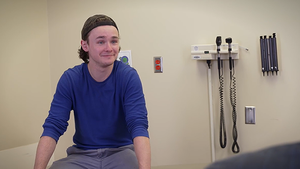How to start conversations with parents about youth firearm injury prevention
As a health care professional, you are committed to helping people stay healthy and safe. Firearm injuries are the leading cause of death for children and teens ages 1-17, and the health care community can help change that.
In the U.S., 4.6 million children live in homes with unlocked and loaded firearms (Source: National Firearm Survey, 2021). Kids are curious and often explore their surroundings, while teens can sometimes be impulsive and reactive. If they are able to find and access guns in their homes, they are likely to handle them, endangering themselves and others. Secure firearm storage is critical to ensuring that someone who shouldn't have access to firearms can't access one.
While the safest way to store firearms is offsite - or, if in the home, locked, unloaded, and stored separately from ammunition, it's important to recognize that these may be significant barriers to your patients. With that in mind, it's helpful to approach the conversation with the goal of encouraging them to rethink how they store their firearms and take the next step to store them more securely. That may mean transitioning from a trigger or cable lock to a lock box. What's most important is ensuring that firearms are locked and inaccessible to children, teens, and anyone else who should not have access. Secure gun storage is a proven way to prevent unintentional firearm injuries and gun suicide.
By talking with parents about firearm injury prevention, health care professionals can help protect young people, save lives, and create safer communities. Here’s how to start a conversation with parents or caregivers about preventing firearm injuries among children and teens. (We have a separate guide with tips for talking directly with children and teens.)
When to start the conversation

Health care professionals regularly screen patients for a variety of health and safety concerns. Talking with families about firearms should be no different from asking about smoking, or screening for depression or anxiety. If you routinely talk with parents about making sure their children wear bike helmets, you can ask about firearm storage at the same time.
How to start the conversation
Tailor your approach based on what you know about the patient and whether or not they have kids. Even if a patient doesn’t have children, their friends or family members may bring kids to their home. As you discuss common household risks, raising the topic of secure firearm storage should be natural. Start the conversation by asking for permission.
Explaining that you routinely ask about firearms because you care about people’s health and safety lets patients know that, whether or not they have guns in their home, you’re not judging their behavior.
“In an effort to keep kids as safe as possible, I always ask patients a few common questions about household safety. Is it OK with you if I do that now?”
“If you have any medication or toxic cleaning products in your home, are they stored where kids can’t get to them? If there are firearms in your home, how do you store them?”
“If you’re arranging for your child to spend time at another child’s home, do you typically ask the parents if they have any unsecured firearms? You could say something like, ‘[Child’s name] is very curious and likes to explore. If you have any firearms at home, are they secured?’”
Find common ground
After you ask a question, stop talking, and give the parent or caregiver an opportunity to express their thoughts. Listen with empathy and without interrupting. Communicate the risks associated with unsecured firearms in a way that will resonate with them. You may not accomplish this goal in the first conversation, but raising the topic opens the door to deeper discussions in the future.
Whether or not you are a firearm owner yourself, remember that most people own firearms out of a desire to protect their families. Even if you don’t know much about firearms, you can educate yourself about firearm counseling and talk with patients about the dangers of unsecured firearms. These conversations are important and provide valuable guidance from the lens of health and safety.
Finding common ground with patients may help put them at ease, make them more likely to trust your recommendations, and encourage them to talk about secure firearm storage with others.
“We both care about your family and want to keep everyone safe. We can agree that no child should ever be hurt by a gun.“
“You’re the expert on your children’s lives, and I can tell you want to protect your family from harm.”
“I appreciate your willingness to have this conversation. I know you want to do what’s best for your child.”
“We both know kids are naturally curious—and that curiosity can lead them into dangerous situations. It's not enough to assume they know better or believe a tragedy can't happen. Whether it's a young child stumbling upon a firearm or a teenager showing one off to friends, the risks are real. Let's work together to identify ways to keep our kids and the kids in our community safe."
After the chat
- Share after-visit summary resources, including secure firearm storage best practices.
- The more of these conversations you have, the more comfortable and confident you’ll feel discussing secure firearm storage and injury prevention with your patients.
- If a patient asks questions you aren’t sure how to answer, let them know you will try to find answers and get back to them. For example, they may want more details about secure firearm storage options or statistics about firearm injuries and young people. Check our resources page to learn more.
Tips for having productive conversations
- Familiarize yourself with local and national resources so that you can share them with patients. For example, many local nonprofits and law enforcement departments offer free firearm locks.
- Avoid using language that could be perceived as political or judgmental. Keep the focus on safety and protecting children and teens from firearm injuries.
- If the parent or caregiver isn’t interested in discussing firearm safety with you, respect that decision. Focus on building trust, and revisit the topic during a future visit.
The information provided on this site is for general education purposes. Consult your health care professional for specific advice. Call or text 988 if you or a loved one is in crisis.
Start a conversation
Resources and tools
The resources available on our site are provided for informational purposes only and do not necessarily reflect the views or positions of the American Medical Association (AMA) or the Advertising Council, Inc.


